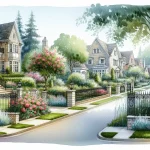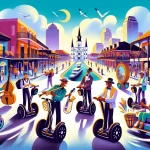New Orleans’ Uptown area is home to the Fontainebleau-Marlyville neighborhood, an enclave that seamlessly blends history, culture, and community spirit. With its tree-lined streets and diverse architectural styles, this area offers a unique glimpse into the city’s heritage and the resilience of its residents.
In This Article
TL;DR
- Fontainebleau-Marlyville’s strategic location within Uptown New Orleans provides easy access to amenities and attractions.
- The neighborhood’s diverse demographic reflects the city’s melting pot of cultures and traditions.
- Ongoing infrastructure improvements and community initiatives aim to enhance residents’ quality of life.
Historical Context of Fontainebleau-Marlyville
Tracing its origins back to the late 19th century, Fontainebleau-Marlyville was initially hindered by the presence of railroad lines that contributed to blight. However, substantial residential growth began in the 1920s, with the construction of raised cottages and Arts & Crafts-inspired homes that now define the neighborhood’s character.
Like many areas of New Orleans, Fontainebleau-Marlyville was impacted by Hurricane Katrina in 2005, prompting extensive recovery efforts and a renewed sense of resilience among residents.
Demographic and Cultural Fabric
Fontainebleau-Marlyville is a true reflection of New Orleans’ diverse cultural tapestry. With a racial makeup of 63% white and 28% African American, according to the 2000 census, the neighborhood is enriched by various ethnic backgrounds and languages.
Residents take great pride in celebrating their cultural heritage through community events and festivals, showcasing the area’s rich traditions and fostering a strong sense of community.
Local Governance and Community Initiatives
The Fontainebleau Improvement Association (FIA) plays a pivotal role in shaping the neighborhood’s future. This community-driven organization works closely with local authorities and residents to address concerns, promote development initiatives, and preserve the area’s unique character.
In the aftermath of Hurricane Katrina, the FIA spearheaded recovery efforts, including rebuilding homes, restoring infrastructure, and advocating for improved public services. Today, the FIA continues to champion projects aimed at enhancing residents’ quality of life.
Economic Landscape and Local Businesses
Fontainebleau-Marlyville’s economic fabric is woven with diverse local businesses, such as family-owned restaurants, boutique shops, and service providers. The area’s proximity to major universities and healthcare facilities also contributes to its economic stability.
Despite these strengths, the neighborhood faces challenges in attracting and retaining certain types of businesses. Ongoing efforts aim to address these challenges and foster an environment conducive to sustainable economic growth.
Education and Institutions
The neighborhood is home to several educational institutions, including Notre Dame Seminary and Dominican High School. Public schools like Lafayette Academy of New Orleans strive to provide quality education to local students.
Beyond traditional settings, specialized programs and initiatives cater to various interests and age groups, contributing to the cultural enrichment of Fontainebleau-Marlyville’s residents.
Public Spaces and Recreation
Despite its urban setting, Fontainebleau-Marlyville offers residents access to public spaces like Marsalis Harmony Park and nearby Palmer Park. These green spaces provide respite, recreational facilities, and gathering spaces, fostering community engagement and promoting physical activity.
Ongoing efforts aim to enhance and maintain these public spaces, ensuring they remain valuable assets for generations to come.
Infrastructure and Urban Planning
Fontainebleau-Marlyville’s infrastructure has undergone significant improvements, with a focus on enhancing transportation, housing, and public utilities. The neighborhood’s strategic location provides residents with easy access to major thoroughfares and public transportation options, including the iconic St. Charles streetcar line.
Urban planning initiatives aim to strike a balance between preserving the area’s historic character and accommodating modern needs, such as improving pedestrian and cyclist infrastructure.
Community Safety and Well-being
Ensuring the safety and well-being of residents is a top priority for the Fontainebleau-Marlyville community. Local organizations and law enforcement agencies work collaboratively to implement crime prevention strategies and promote neighborhood watch programs.
Access to healthcare facilities and wellness resources is also a key concern, with the neighborhood’s proximity to major hospitals and medical centers providing convenient access to quality healthcare services.
Community-driven initiatives, such as fitness classes and health fairs, further promote healthy lifestyles and raise awareness about wellness-related topics, contributing to the overall well-being of residents.






